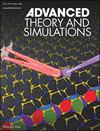Optimizing Core Modifications for High‐Performance D‐A‐D Molecular Systems: a Multi‐Faceted Study on NLO Properties, Solvent Effects, Charge Transfer, and Photovoltaic Efficiency
IF 2.9
4区 工程技术
Q1 MULTIDISCIPLINARY SCIENCES
引用次数: 0
Abstract
Developing materials with strong nonlinear optical (NLO) response is crucial for advancing optoelectronic technologies. This study investigates the electro‐optical behavior of thiadiazole‐based derivatives (PAH‐P to PAH‐BTZ‐3), designed through central core modifications to enhance NLO performance. Quantum chemical calculations were conducted using density functional theory (DFT) with M06‐2X functional and 6‐311G** basis set. Among the studied compounds, PAH‐BTZ‐3 exhibited the highest third‐order NLO polarizability <γ> of 1294.7 × 10优化高性能D - A - D分子体系的核心修饰:NLO性质、溶剂效应、电荷转移和光伏效率的多方面研究
开发具有强非线性光学响应的材料对于推进光电技术的发展至关重要。本研究研究了噻二唑基衍生物(PAH - P至PAH - BTZ - 3)的电光行为,这些衍生物通过核心修饰来提高NLO性能。量子化学计算采用密度泛函理论(DFT),采用M06‐2X泛函和6‐311G**基集。在所研究的化合物中,PAH‐BTZ‐3具有最高的三阶NLO极化率<;γ>;为1294.7 × 10−36 esu,是基准分子对硝基苯胺(p‐NA)的约168倍。利用极化连续统模型(PCM)和类导体筛选模型(COSMO)证明的溶剂效应表明,γ <γ>;与气相相比的值。频率依赖分析显示,PAH‐BTZ‐3的最大γ(−ω;ω,0,0)和γ(−2ω;ω,ω,0)值分别为3673.8 × 10−36 esu和7076 × 10−36 esu,突出了共振重吸收。前沿分子轨道(FMO)分析表明,临界轨道能隙从5.80 eV减小到3.74 eV。紫外可见光谱证实了PAH - BTZ - 3的分子内电荷转移,在552 nm处最大红移。光伏参数,如开路电压范围从1.57 eV到2.89 eV,表明这些化合物在太阳能应用中的潜力。
本文章由计算机程序翻译,如有差异,请以英文原文为准。
求助全文
约1分钟内获得全文
求助全文
来源期刊

Advanced Theory and Simulations
Multidisciplinary-Multidisciplinary
CiteScore
5.50
自引率
3.00%
发文量
221
期刊介绍:
Advanced Theory and Simulations is an interdisciplinary, international, English-language journal that publishes high-quality scientific results focusing on the development and application of theoretical methods, modeling and simulation approaches in all natural science and medicine areas, including:
materials, chemistry, condensed matter physics
engineering, energy
life science, biology, medicine
atmospheric/environmental science, climate science
planetary science, astronomy, cosmology
method development, numerical methods, statistics
 求助内容:
求助内容: 应助结果提醒方式:
应助结果提醒方式:


